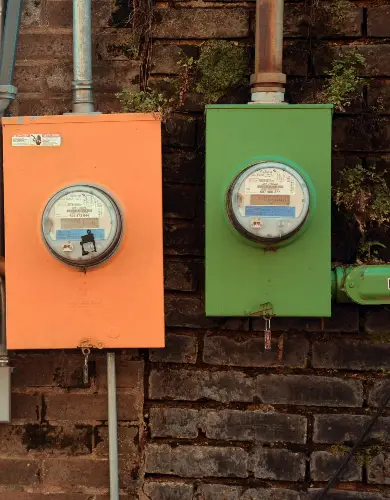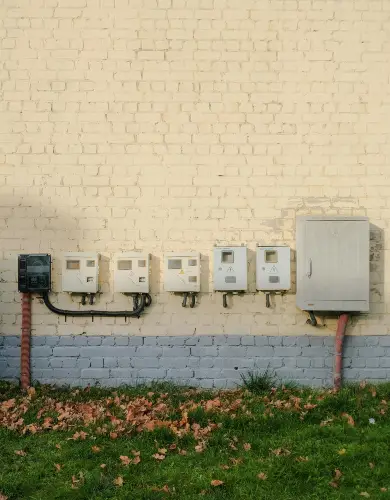Understanding multi-rate energy meters for business
Multi-rate business energy meters allow companies to pay business electricity prices that depend on the time of day they use power. By shifting energy use into cheaper off-peak hours, businesses can reduce costs and make their electricity spend more efficient.
In this guide, we’ll cover:
- What is a multi-rate meter?
- How do multi-rate meters work?
- Benefits of multi-rate meters for businesses
- What’s the difference between a multi-rate meter and a standard meter?
What is a multi-rate meter?
A multi-rate meter is a type of business electricity meter that records how much energy you use at different times of the day. Instead of applying a single flat rate, it allows business energy suppliers to charge separate unit rates based on when power is consumed.
These meters are key to accessing time-of-use tariffs. They give businesses the chance to lower costs by shifting energy use into cheaper periods.
Common examples include day and night meters, peak and off-peak meters, and Economy 7 meters.
Multi-rate meters are different from single-rate meters, which charge the same unit rate for every kilowatt-hour (kWh) used, regardless of when it is consumed.
How do multi-rate meters work?
Multi-rate meters utilise time-dependent meter readings, enabling businesses to utilise electricity tariffs that incorporate more than one unit rate. Instead of charging a single flat price, these tariffs vary depending on when electricity is consumed.
Meters record usage
Multi-rate meters track electricity in separate time periods. Modern devices such as smart meters and half-hourly meters record and send usage automatically, while older Economy 7 and Economy 10 meters still provide dual rates but rely on manual readings.
Time-based tariffs
Suppliers then use this data to apply different prices depending on when electricity is used.
Off-peak periods, such as nights or weekends, are generally cheaper, while peak hours incur higher costs. For example, a business running equipment after 7pm could save by shifting more of its consumption into the lower-rate band.
Contract features remain the same
Even with multiple unit rates, multi-rate tariffs still encompass all the standard elements of business energy contracts, including business electricity standing charges, the Climate Change Levy, and VAT on business energy charges.
💡 Multi-rate tariffs are only available for electricity connections. Business gas suppliers do not offer multi-rate business gas prices.
Benefits of multi-rate meters for businesses
Multi-rate meters provide companies with opportunities to reduce costs and manage electricity more efficiently. By recording usage at different times of day, they open access to tariffs that better reflect how your business actually operates.
Lower energy costs
Businesses that can shift power-hungry activities into evenings, nights, or weekends benefit from cheaper off-peak rates. This makes multi-rate meters especially valuable for companies with flexible operations.
Greater control over usage
By separating peak and off-peak consumption, these meters give clear visibility of when electricity is most expensive. This allows managers to plan production schedules, cleaning cycles, or EV charging times around lower rates.
Suitable for energy-intensive industries
Manufacturers, warehouses, bakeries, data centres, and businesses with EV fleets can take advantage of multi-rate tariffs. Many of their high-demand processes, such as running industrial machinery, can be scheduled for off-peak times.
Encourages energy efficiency
Multi-rate meters motivate businesses to be more efficient by rewarding off-peak use. Shifting heavy processes into lower-rate hours often means reorganising workflows, reducing idle equipment use, and cutting unnecessary daytime consumption. This not only lowers costs but also helps businesses operate with less overall energy waste.
What’s the difference between a multi-rate meter and a standard meter?
The key difference is how your electricity is billed. A standard meter applies the same price for every unit of electricity, while a multi-rate meter allows different prices to be applied depending on when the power is used.
Here’s a quick comparison:
| Feature | Multi-rate meter | Standard (single-rate) meter |
|---|---|---|
| How it measures usage | Records electricity separately across time bands such as day/night or peak/off-peak | Records all usage as a single time band |
| Billing structure | Applies different unit rates depending on when energy is used | One fixed unit rate at all times |
| Best for | Businesses with flexible operating hours or high night/weekend usage | Businesses with steady, round-the-clock electricity needs |
| Potential savings | Can reduce costs by shifting consumption into cheaper off-peak periods | No savings possible by changing usage patterns |
FAQs about multi-rate meters
Businesses often want to know how multi-rate meters work in practice, who needs them, and how to obtain one for installation. Below we’ve answered some of the most common questions.
Can I get a multi-year contract with a multi-rate meter?
Yes. Multi-rate tariffs are available on the same contract lengths as standard business electricity deals, including one, two, three or even five years. This allows you to fix both your peak and off-peak unit rates for the full term of the agreement.
Do you need a multi-rate meter?
A multi-rate meter is not essential for every business. They tend to suit companies that:
- Operate heavily outside peak hours
- Run energy-intensive processes overnight or at weekends
- Manage multiple sites or departments with varied usage patterns
- Want to participate in the demand flexibility service; or
- Want to track energy consumption for SECR reporting
If your electricity use is steady throughout the day, a single-rate meter may be simpler and more cost-effective.
How to get a multi-rate meter installed
Most suppliers now offer a free smart meter upgrade that supports multi-rate tariffs. To get one installed:
- Review your energy-intensive operations to see if they can be shifted into off-peak periods to maximise savings.
- Check if you already have a compatible meter type. If not, arrange a business electricity meter installation.
- Compare business electricity rates to find the best multi-rate tariff for your needs.
- Sign a new business energy contract to start your business energy switch. Installation typically takes 2–4 weeks, and in some cases, your existing meter can be reprogrammed instead of replaced.

